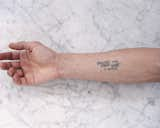The Wong Show
Other companies were not as accepting of Wong's work. In a collaboration with Ju$t Another Rich Kid, Wong turned a McDonald's coffee stirrer (an infamous 1980s "icon" that frequently appeared as evidence in drug trials) into a coke spoon.
Tobias Wong and Ju$t Another Rich Kid,
Coke Spoon 01, Coke Spoon 02 and Swizzle Stick, from the Indulgent series, 2005; metal; Collection SFMOMA, © Estate of Tobias Wong and Ju$t Another Rich Kid; photo: courtesy SFMOMA.
Wong's works grappled with perceptions of safety and security in post-9/11 America. This quilt is made from ballistic nylon, a material typically used in military applications as a protective shield from flying debris. Here, Wong uses the material in a quilt (a comforting object) with a rather traditional pattern, commenting on a need for a different sense of comfort and security.
Tobias Wong,
Bulletproof Quilted Duvet, 2004, ballistic nylon, cotton, and cotton flannel; Collection SFMOMA, gift of Josee Lepage; © Estate of Tobias Wong; photo: courtesy SFMOMA.
When Wong passed away in June of 2010, the art and design worlds lost one of their brightest stars. "There may be others on similar frequencies, but I'd be hard pressed to find someone who did something as significant for—and against—contemporary design as Tobi did," says Henry Urbach, who heads SFMOMA’s Department of Architecture and Design and organized the exhibition with assistant curators Jennifer Dunlop-Fletcher and Joseph Becker.
A career that burned so brightly for such a short time makes a retrospective a difficult feat to accomplish, especially since his impacts are not fully known. Admittedly, Urbach says they created a "shrine" to Wong. The exhibition is staged in a tomb-like intimate space—a treatment worthy of the objects on display.
Objects are lovingly arranged atop a long pedestal and demand close inspection to catch all of their minute details. The overturned diamond setting in Killer Ring (2002) turns a luxury object into a weapon; the NYC Story matchbook (2002) in which Wong cut individual matches into New York City’s iconic skyline, leaving only two intact—symbols of the twin towers; a garland of wooden beads (2010) that reads "New York I Love You But You’re Bringing Me Down" in Morse code, Wong’s last work that appropriates the title of an LCD Soundsystem song.
Wong’s work appears in a variety of settings, including museum galleries, retail stores, and design fairs (which Wong chose to exhibit in over art fairs). After he exhibited This is a Lamp (a riff of Philippe Stark’s Bubble Chair for Kartell) at ICFF in 2001, he was thrust front and center into the art world. The myriad settings his work is found in affords him a rare position to have a broad impact since there isn’t a single creative silo limiting him. "I don’t draft or create models/prototypes, I don’t problem solve and I definitely don’t make things to make life easier," Wong said in 2008. At times he’s described as an artist, a designer, an "enfant terrible," and a prankster, but overall he was a critic concerned with posing questions over positing answers.
"I think Tobi understood design as a kind of mirror that both reflects social conditions and can be used to propose new ones," Urbach says. "He assumed a stance we might recognize as alienated or ironic and yet — what makes his work endlessly fascinating—there is also a tremendous sense of enthusiasm, care, and generosity."
Despite Wong’s resistance to be categorized, his work has been situated among historic figures like Duchamp, the Situationists, and along with contemporary figures like Diller Scofidio + Renfro. Some could argue that a retrospective staged so soon after Wong’s death is an opportunistic move by the museum, but it’s an apt compliment to the accompanying ParaDesign exhibition, which includes objects (all from SFMOMA's permanent collection) that aren’t quite architecture and design, but a reflection of them. The works in ParaDesign are by many familiar names—Roy McMakin, SANAA, and Tom Dixon among others—but no individual or design team seems to so wholly embody the exhibition’s tenor as Wong.
"Together these exhibitions have the capacity to communicate a concept of design as critically engaged, a terrain of research that is profoundly creative," Urbach says.
Though Wong's work can be firmly placed in a historic trajectory, only time will reveal how the next generation of artists will be impacted by his work.
"We don’t yet know who Toby will have influenced," says Urbach, speaking of the next generation of artists and designers. Urbach expects, however, that museum visitors will take away something more immediate.
"I expect the exhibition will stimulate curiosity, understanding, and respect for Tobi’s work," he says. "I would also hope that—alongside ParaDesign—it raises awareness of designers and artists who work in ways that are critical, conceptual, and speculative. A necessary complement to more conventional and professional forms of practice, ParaDesign aims to challenge norms, undermine habits, and awaken."
"Tobias Wong" and "ParaDesign" will be on view at SFMOMA until June 19th. For more information, please visit sfmoma.org.
Published
Last Updated
Get the Dwell Newsletter
Be the first to see our latest home tours, design news, and more.






